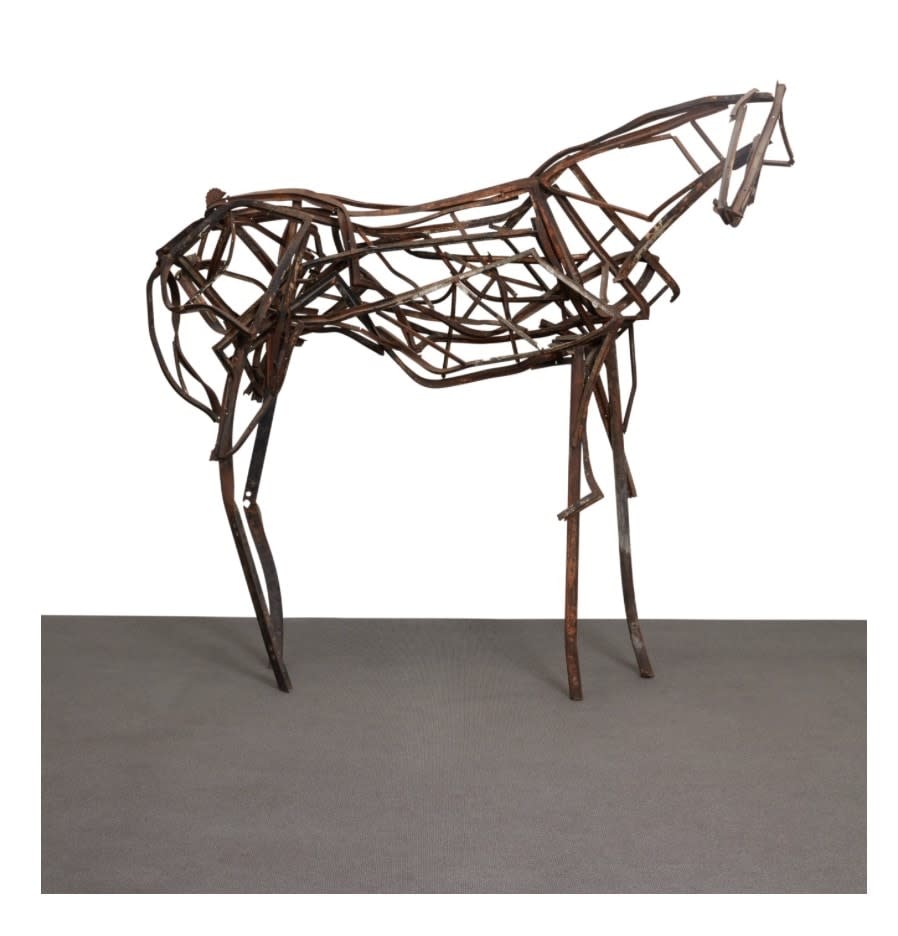artist
Butterfield’s art conveys both a deep love for and a respect for these magnificent animals. Born the same day as the 75th anniversary of the Kentucky Derby, Deborah Butterfield has been crafting horses out of scavenged and discarded materials since the 1970’s. At her Montana ranch Butterfield trains, rides and generally bonds with her horses during the summer months. Today there is great demand for her equine sculptures. Sculpting only during the long winter months, Butterfield now may take 3-5 years to complete a work. In her later works, as in our example, Butterfield addresses her sculptures with a more abstract approach. Beginning in 1985 she made a dramatic switch from sticks, mud grass, and wire to bronze for her sculptures, once she discovered what she could do with this metal.
"It was the most fun I ever had. I had all this expressive material that wasn’t long for this world, rotting sticks in piles, and when they were transformed into bronze I could use them. Now I have steel moods and bronze moods."
—Deborah Butterfield
As a horsewoman Butterfield understands the horse. How she constructs the horse, how she places the sculpture in a certain space is evidence of her acute knowledge of this majestic animal. Yet she also understands the materials—what to use, what to manipulate, and what to change-evidence of her accomplishment as a sculptor. Knowledge of the two creates a work that is the true essence of this creature and her art.
Description
Metrical is a captivating steel rendition of Butterfield's renowned subject matter, the horse. The sculpture is formed by intertwining and overlapping steel scraps, creating a gentle yet intricate interpretation of a horse. The rusted red and brown tones of the steel resemble the colors found on a real horse, eliciting the character, and further referencing the magnificent creatures.
One notable aspect of Metrical is its slender legs and lightweight structure in the upper body, which impart a sense of delicacy to the sculpture. This contrast between the fragile appearance of the work and the robustness of the steel material adds an intriguing dynamic to the artwork and reinstates Butterfield’s thematic logic. The act of creating these sculptures necessitates that Butterfield is ruthless with her materials. In some ways, Butterfield’s story is one of a contemporary woman still of tough determination as many women of the American West have been. Her horses are modeled from the perspective that the artist does dressage and that this special relationship with the horse informs her modeling of them and how they are built.
In Butterfield's body of work, horses are typically depicted in reclining, prone, or resting positions, serving as symbols of femininity. By choosing to portray horses in this manner, Butterfield subverts the traditionally masculine and occasionally chauvinistic realm of horsemanship. Metrical follows this trend by depicting the horse in a still position and maybe even looking back at the viewer or environment. This further integrates the sculpture into reality and solidifies it into the space. Perceived by most as powerful utilitarian animals best for hard labor or combat, horses instead appealed to Butterfield as symbols of grace and peace. We embrace the importance of her work. Although very personal to her it also has an outward place of importance in contemporary sculpture. That of an artist working in a technological era which makes art of an organic nature desired and relevant.
The first thing that I saw in my life that I remembered looking important and wonderful was a horse. I was just moved by them in a non-rational, passionate way before I even had words to describe it.”
-Deborah Butterfield
Butterfield’s move to a ranch in Montana in 1979 sparked a transition of method and material toward the use of scrap metal, steel, barbed wire, pipes, and discarded fencing. Metrical is a evidence of this transition as it is constructed with steel scraps of what seems to be the metal frame of car windows.
provenance
Edward Thorp Gallery, New York
Acquired from the above by the present owner in 1997.
Accompanied by certificate of authenticity issued by Buck Butterfeild, inc
exhibitions
Edward Thorp Gallery, Deborah
Butterfield, New York, 1997





